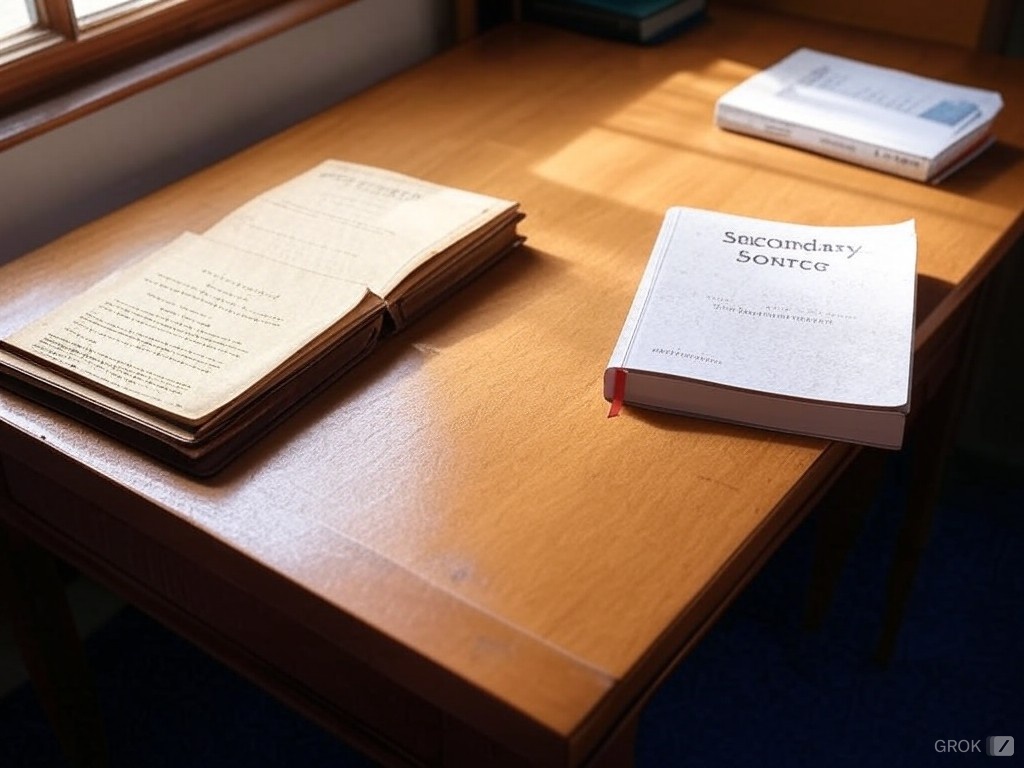Primary vs Secondary Sources: A Comprehensive Guide

Primary vs Secondary Sources: A Comprehensive Guide
Understanding the distinction between primary and secondary sources is fundamental to academic research. Whether you're writing a research paper, thesis, or scholarly article, knowing how to identify, evaluate, and effectively use different types of sources will strengthen your research and academic writing.
This comprehensive guide will explore the characteristics of primary and secondary sources, their roles in research, and how to use them effectively in your academic work. We'll provide clear examples and practical strategies for incorporating both types of sources into your research.
Primary Sources
Original materials or evidence created during the time period being studied or by individuals directly involved in the events.
Secondary Sources
Works that analyze, interpret, or discuss primary sources and events, typically created after the fact by people not directly involved.
Primary Sources
-
Types of Primary Sources
- Personal documents (diaries, letters)
- Official records (government documents)
- Creative works (art, literature)
- Research data (experiments, surveys)
- Media recordings (photographs, videos)
- Artifacts (objects, buildings)
-
Characteristics
- Created during the time period
- First-hand accounts
- Original research
- Direct evidence
- Uninterpreted data
-
Examples by Field
- History: Letters, diaries, newspapers
- Literature: Original manuscripts
- Science: Lab reports, raw data
- Art: Original artworks
- Social Sciences: Interview transcripts
Secondary Sources
-
Types of Secondary Sources
- Academic books
- Journal articles
- Literature reviews
- Textbooks
- Biographies
- Documentaries
-
Characteristics
- Analysis of primary sources
- Interpretation of events
- Synthesis of information
- Critical evaluation
- Historical perspective
-
Examples by Field
- History: History textbooks, biographical studies
- Literature: Literary criticism, book reviews
- Science: Review articles, meta-analyses
- Art: Art history books, exhibition catalogs
- Social Sciences: Theory books, case studies
Source Comparison Example
Topic: Civil War Battle
Primary Source: Soldier's diary entry from the battlefield
Secondary Source: History book analyzing the battle's strategic importance
Evaluating Sources
-
Authority
- Author credentials
- Publisher reputation
- Institutional affiliation
- Peer review status
- Citation frequency
-
Accuracy
- Factual correctness
- Source documentation
- Methodology
- Data verification
- Expert consensus
-
Currency
- Publication date
- Latest edition
- Field developments
- Updated information
- Historical context
-
Purpose
- Intended audience
- Research objectives
- Potential bias
- Academic rigor
- Educational value
Using Sources Effectively
-
Research Strategy
- Start with secondary sources
- Identify key primary sources
- Cross-reference materials
- Document relationships
- Build source networks
-
Integration Methods
- Direct quotations
- Paraphrasing
- Summary
- Synthesis
- Critical analysis
-
Balance Considerations
- Mix source types
- Consider perspectives
- Address contradictions
- Maintain objectivity
- Support arguments
- Verify source authenticity
- Document source relationships
- Maintain proper citations
Frequently Asked Questions
Yes, some sources can function as both primary and secondary sources depending on how they're used. For example, a history textbook is typically a secondary source, but if you're studying how historical events were interpreted in different eras, the textbook becomes a primary source.
Neither type is inherently more valuable; their usefulness depends on your research goals. Primary sources provide direct evidence and original perspectives, while secondary sources offer analysis and context. Most strong research projects use both types effectively.
Primary sources can be found in archives, special collections, museums, and increasingly, digital repositories. Many universities and libraries maintain databases of primary sources. Start by consulting research guides in your field and speaking with librarians specializing in your area of study.
Other Articles You Might Like
Can AI Writing Tools Teach You to Write Like Famous Authors?
Exploring how artificial intelligence can analyze and mimic the distinctive styles of literary legends—from Hemingway to Austen—and whether these tools can actually help improve your own writing through stylistic imitation.
Do College Admission Officers Use AI to Detect AI-Written Essays?
An in-depth investigation into how college admissions offices are responding to AI-generated essays, what detection technologies they're using, and how students can ensure their applications remain authentic.
Common AI Writing Mistakes and How to Avoid Them
Artificial Intelligence (AI) has revolutionized the content creation industry. Tools like ChatGPT and other advanced AI writers have made generating content faster and more accessible, particularly for businesses and individuals looking to scale their content production. However, despite its advantages, AI writing isn't without its flaws. AI can produce content filled with errors that affect readability, credibility, and SEO effectiveness. If you're leveraging AI to power your writing needs, it's crucial to recognize these common pitfalls and learn how to rectify them. This blog post will guide you through some of the most frequent mistakes AI makes in content creation, providing you with actionable solutions to elevate the quality of your AI-generated content.
How to Ethically Use AI Essay Tools While Maintaining Academic Integrity
A comprehensive guide to incorporating AI writing assistance into your academic work ethically, with practical strategies for proper attribution, transparent use, and maintaining your authentic voice and intellectual contribution.
How AI Analyzes Your College Essay: The Technology Behind It
Dive deep into the sophisticated AI technology that powers college essay review tools, from natural language processing to machine learning algorithms that evaluate structure, style, and content.
AI Writing Tools and the Death of Writer's Block: Do They Really Work?
An evidence-based investigation into whether artificial intelligence can truly overcome creative blockages, examining how writers are using these tools to jumpstart their creativity, the psychological mechanisms at play, and when traditional methods might still work better.
